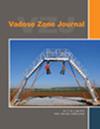Evaluation of soil water content and bulk electrical conductivity across the U.S. Climate Reference Network using two electromagnetic sensors
IF 2.8
3区 地球科学
Q3 ENVIRONMENTAL SCIENCES
引用次数: 0
Abstract
Soil bulk electrical conductivity (BEC) was evaluated alongside soil volumetric water content (VWC) and soil temperature measurements using the HydraProbe (model HydraProbe, Stevens Water Monitoring Systems, Inc.) (hereafter called HP) with accuracy range of BEC ≤ 0.3 S m使用两个电磁传感器评估整个美国气候参考网络的土壤含水量和体积电导率
使用 HydraProbe(型号 HydraProbe,Stevens Water Monitoring Systems, Inc.以下简称 HP)和时域反射仪 (TDR)-315L 探头(型号 TDR-315L,Acclima,Inc.)(以下简称 AP)进行了评估,前者的精度范围为 BEC ≤ 0.3 S m-1,后者的精度范围为 BEC ≤ 0.6 S m-1。之前的评估显示,在将介电常数测量值转换为 VWC 时,使用制造商推荐的校准方法,这两种传感器在某些粘土中的性能并不一致。在这里,我们发现在粘土含量较高的土壤中,每小时的 BEC 值达到 0.6 S m-1,而在高盐度土壤中则超过 2 S m-1,这些高 BEC 值与 HP 和 AP 传感器的性能不佳和故障有关。较大的 BEC 值出现在主要饱和的土壤中,盐碱土的 VWC 值达到约 0.5 立方米/立方米,粘土的 VWC 值达到约 0.7 立方米/立方米,而较低的 BEC 值则与土壤含水量低和很少饱和有关。在各种类型的土壤中都能观察到每小时小于 0.1 S m-1 的较低 BEC 值,在这些土壤中,传感器的性能通常非常出色。对 BEC 影响最大的因素是土壤含水量高。虽然在估算土壤含水量时介电常数测量对 BEC 很敏感,因为一些高粘土含量和高盐度土壤会增加 BEC,但在排水良好的表层土壤中,大 BEC 对介电常数测量的影响要小于接近饱和的深层土壤。土壤温度对介电常数的影响很小。在粘土含量高和盐度高的情况下,粘土矿物的比面积也与 BEC 的大小有关。
本文章由计算机程序翻译,如有差异,请以英文原文为准。
求助全文
约1分钟内获得全文
求助全文
来源期刊

Vadose Zone Journal
环境科学-环境科学
CiteScore
5.60
自引率
7.10%
发文量
61
审稿时长
3.8 months
期刊介绍:
Vadose Zone Journal is a unique publication outlet for interdisciplinary research and assessment of the vadose zone, the portion of the Critical Zone that comprises the Earth’s critical living surface down to groundwater. It is a peer-reviewed, international journal publishing reviews, original research, and special sections across a wide range of disciplines. Vadose Zone Journal reports fundamental and applied research from disciplinary and multidisciplinary investigations, including assessment and policy analyses, of the mostly unsaturated zone between the soil surface and the groundwater table. The goal is to disseminate information to facilitate science-based decision-making and sustainable management of the vadose zone. Examples of topic areas suitable for VZJ are variably saturated fluid flow, heat and solute transport in granular and fractured media, flow processes in the capillary fringe at or near the water table, water table management, regional and global climate change impacts on the vadose zone, carbon sequestration, design and performance of waste disposal facilities, long-term stewardship of contaminated sites in the vadose zone, biogeochemical transformation processes, microbial processes in shallow and deep formations, bioremediation, and the fate and transport of radionuclides, inorganic and organic chemicals, colloids, viruses, and microorganisms. Articles in VZJ also address yet-to-be-resolved issues, such as how to quantify heterogeneity of subsurface processes and properties, and how to couple physical, chemical, and biological processes across a range of spatial scales from the molecular to the global.
 求助内容:
求助内容: 应助结果提醒方式:
应助结果提醒方式:


